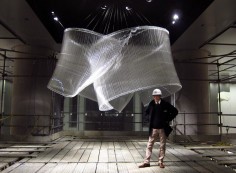NIKOLAS WEINSTEIN
source: lookingatglasswordpress
Nikolas Weinstein Studios in Tokyo
sculpture installation by Nikolas Weinstein Studios. The billowing sculpture is now located in a new office building in the Akasaka neighborhood of Tokyo, Japan. The building was built by, and for, Kajima Corporation to house some of their corporate offices. The interior design firm for the project was ILYA (a subsidiary of Kajima Corporation).
This project involved a lot seismic considerations and there was a great deal of collaboration between the NWS office, their consulting engineers at ARUP in London and Tokyo, and the teams at ILYA and Kajima.
As with most installations, we see only the finished project. I am always amazed at the amount of time and effort that goes into designing and installing these sculptures. Nik and his crew do a fantastic job of documenting what goes into a project. Let’s take a look at the design process from start to finish.
.
.
.
.
.
.
.
source: handfulofsalt
Nik’s installation in Tokyo, viewed from several stories high. Photo: Sam Prest.
Earlier this summer, one of our favorite companies, Nikolas Weinstein Studios met with Under Secretary of Commerce for International Trade, Francisco Sanchez. At this August meeting, Nik and his team, who create stunning glass installations, were awarded an Export Achievement Certificate for the impressive amount of exports they’ve shipped to places like China, India, and Japan.
This award was actually part of a larger, longer relationship between Team Weinstein and the local branch of the US Commercial Service (nestled in the Department of Commerce) that helps facilitate exports from small businesses. It’s a relationship that’s helped yield a substantial amount of work for the studio, as 90% of the studio’s work is exported. And that means jobs have been created for people with craft skills and art degrees as well. (This is, apparently, part of a movement called “insourcing”.)
What’s the relationship between design and US trade? Stephan Crawford, the Director of the US Export Assistance Center in San Francisco, notes, “Since design is at the “front-end” of large scale projects, having US firms involved in the design phase can increase the chances of US participation downstream as a project is implemented.”
Larger companies have traditionally benefited from this kind of export assistance, but Nik, with his smarts and professionalism, and the sheer coolness and uniqueness of his work, has been able to do what most small companies have not.
Here’s how it works: By collaborating with the Commercial Service’s Export Assistance Center, a small business with something to export (we recommend taking a page from Nik and Co. and focusing on high quality/high skill products) can gain a deeper understanding of a particular marketplace, identify partners, and deal with tricky documentation and logistical challenges. On the ground in the export market, this service helps foster networking, door-opening, cultural and business guidance, and so much more.
Kudos to Nik and his team. Perhaps it’s time to rethink what government can do for you.


